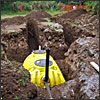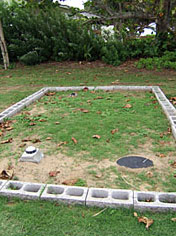Contact EPA Pacific Southwest Groundwater
Pacific Southwest, Region 9
Serving: Arizona, California, Hawaii, Nevada, Pacific Islands, Tribal Nations
Underground Injection Control (UIC)
| Underground Injection Control (UIC) Quick Finder | ||
|---|---|---|
| Ground Water HomeUIC Home | Cesspools in HawaiiClass V Wells | UIC PermitsOnsite Sewage Treatment |
National Information


Cesspools in Hawaii
On this page:
- Does this rule apply to me?
- Success Stories
- Compliance and Enforcement
- Other Frequently Asked Questions
- Regulatory terms defined
- Contact Information
Cesspools, which are also called "drywells", are underground holes used throughout Hawaii for the disposal of human waste. Raw, untreated sewage is discharged directly into the ground, where it can can contaminate oceans, streams and ground water by releasing disease-causing pathogens and nitrates.
EPA regulations required all existing large capacity cesspools to be closed and replaced with an alternative wastewater system by April 5, 2005. Since 2000, EPA has prohibited the construction of new large capacity cesspools nationwide (UIC) regulations. The regulations do not allow an extension of the deadline.
Cesspools are more widely used in Hawaii than in any other state in the country. EPA Region 9 is responsible for implementing the regulations in Hawaii and works with the Hawaii State Department of Health (DOH) ![]() to ensure effective implementation.
to ensure effective implementation.
In states with delegated Underground Injection Control (UIC) programs, the individual state is responsible for implementation of these regulations. If you are an owner or operator of a cesspool located outside of Hawaii, please contact the appropriate state representative on the contacts page. Also see EPA's national cesspool page for additional information.
Does this rule apply to me?
Does your property use a cesspool for wastewater disposal?
NO
If you do not use a cesspool for wastewater disposal, this rule does not apply to you. |
||
| YES | My property is residential
On your residential property, do two or more dwellings discharge into the same cesspool? (This includes apartment buildings; multi-unit condominiums; duplexes, a house with a rental unit or ohana; neighboring homes that collectively dispose of wastewater into one cesspool.) |
My property is commercial
Do you own or operate a commercial property that serves 20 or more people on any day including employees? |
You have a large capacity cesspool…now what?
Submit an Inventory Form
Find an Alternative Wastewater System
Submit a Compliance Plan
Upon completion, notify EPA of upgrades and changes to your wastewater system
Success Stories

Carol Yamamura took action after reading about the large capacity cesspool ban in the Maui News; realizing the ban applied to the cesspool for her house and cottage. She updated her home’s wastewater system, not only to comply with the new law, but also to protect the environment. “I decided to do it on my own; it wasn’t like I was told to do it.” Read the full story...
Acting on the large capacity cesspool ban was one of Mr. Bates’ first projects when he was elected Junior Warden of St. John’s Episcopal Church in January 2005. Along with complying with federal law, Mr. Bates recognized the importance of closing the Church’s cesspool. Read the full story...
Compliance and Enforcement
EPA's enforcement activities are designed to investigate and bring cases against individuals or facilities found in violation of the Safe Drinking Water Act's UIC regulations. Those found in violation may face enforcement action and fines. EPA is authorized to issue administrative orders requiring compliance and assessing an administrative civil penalty of no more than $16,000 for each day of each violation, up to a maximum penalty of $177,500, against any person who violates the Safe Drinking Water Act.
EPA Region 9 has entered into Consent Agreements with a number of entities, including public agencies, businesses and residential facilities, to address violations of the large capacity cesspool requirements. These enforcement actions required closure of about 1,100 large capacity cesspools statewide.
Other Frequently Asked Questions
- How do cesspools work?
- What is a large capacity cesspool?
- How is EPA identifying LCCs across the state?
- What does it mean to have the capacity to serve 20 or more persons per day?
- What if my cesspool disposes of more than just sanitary waste?
- My cesspool meets state rules, does the ban and closure requirement apply to me?
How do cesspools work?
Cesspools are “drywells” or underground holes that receive sanitary wastewater from building bathrooms and usually from the kitchens, clothes washers and/or dishwashers. A cesspool has an open bottom and/or perforated sides and the wastewater leaves the home and goes through a pipe into the underground chamber. While cesspools are designed to capture sanitary waste, they do not treat waste. The wastewater flows into the chamber; the wastes seep into the ground, but sometimes the solids remain inside the underground chamber.

What is a large capacity cesspool?


A large capacity cesspool is one that discharges sanitary waste with human waste and serves: (1) a multiple dwelling; OR (2) a non-residential location with the capacity to serve 20 or more persons per day. Single-family homes connected to their own individual cesspool are not subject to the federal UIC regulations. The number of persons served by a residential cesspool and the quantity of flow received by a cesspool are not specific considerations in the federal definition of a large capacity cesspool. However, if the flow to the cesspool is greater than 1000 gallons per day (gpd), it is also subject to the State of Hawaii’s Underground Injection Control (UIC) rules regardless of the number of persons served per day, which are implemented by the Safe Drinking Water Branch, UIC program.
How is EPA identifying large capacity cesspools across the state
EPA works closely with the Hawaii Department of Health, using its inventory of cesspools across the state as a reference source. The DOH, Counties and other entities refer suspected and known large capacity cesspools owners to EPA for follow-up. EPA also enforces this rule through public referrals, complaints and property transfers. Through random inspections of unsewered areas, EPA can also identify large capacity cesspools. Enforcement actions have been taken addressing over 900 large capacity cesspools state-wide.
What does it mean to “have the capacity to serve 20 or more persons per day?”
For Hawaii, any cesspool that receives waste from 20 or more persons in any single 24-hour period is considered a large capacity cesspool, such as a church where 20 persons attend on any one day a week; or a business with 10-15 employees, plus 5-10 visitors on a given day.
What if my cesspool disposes of more than just sanitary waste?
A cesspool receiving a combination of sanitary waste and/or a commercial waste, such as a cesspool serving a hospital, laundromat or supermarket is an industrial well. It is subject to federal and Hawaii DOH UIC regulations. If the cesspool serves 20 or more persons, it must be closed by April 2005.
In addition, under state rules, new individual wastewater systems used to replace a large capacity cesspool receiving less than 1000 gallons per day cannot be used for industrial wastewater disposal unless pretreatment is first provided. These systems must upgrade to an alternative wastewater disposal system. Cesspools receiving flows of greater than 1000 gallons per day and all injection wells must apply for a permit from the Hawaii DOH UIC program.
The Hawaii DOH may require the owner of an existing cesspool to upgrade if it intersects the ground water table. The new wastewater disposal system cannot discharge directly into ground water. Discharge of untreated sewage directly into the water table presents an even greater risk to public health than discharge to soil above the water table, particularly in the transport of viruses.
My cesspool meets state rules, does the ban and closure requirement apply to me?
The federal regulations are an independent obligation for cesspool owners or operators above and beyond compliance with state requirements. All large capacity cesspools must be closed after an alternative wastewater system is installed.
Regulatory Terms
The following definitions are provided to assist you with understanding the regulatory requirements and are taken from the federal UIC regulations and Hawaii Administrative Rules ![]() , Title 11, Chapters 23 and 62.
, Title 11, Chapters 23 and 62.
Cesspool: a well that receives untreated sanitary waste containing human excreta, and may have an open bottom and/or perforated sides.
Individual Wastewater System: a facility designed to receive and dispose of no more than 1000 gallons per day of domestic wastewater.
Sanitary waste (domestic waste): liquid or solid wastes originating from human activities, such as wastes collected from toilets, showers, wash basins, sinks used for cleaning domestic areas, food preparation, clothes or dish washing operations.
Seepage pit: an excavation in the ground which receives the discharge from treatment units and permits the effluent to seep through its bottom or sides to gain access to the underground formation.
Septic system: a system used to place sanitary waste below the surface and is typically comprised of a septic tank and subsurface fluid distribution system or disposal system, such as a leach field, absorption trenches or seepage pit. For additional information on septic systems, see EPA’s Septic Systems web page.
Contact Information
Kate Rao
(rao.kate@epa.gov)
(415) 972-3533
Mailing Address
Region 9 Large Capacity Cesspool Coordinator
EPA Region 9 Water Division
75 Hawthorne Street
San Francisco, CA 94105
Toll-free at (866) EPA-WEST (866) 372-9378
Disclaimer:
- The statements on this page are intended solely as technical assistance. This information is not intended, nor can it be relied upon, to create any rights enforceable by any party in litigation with the United States.
- This page updates the information provided in Ban on Large Capacity Cesspools to Protect Public Health in Hawaii, (EPA 909-F-04-05, May 2004 Update/HI)
